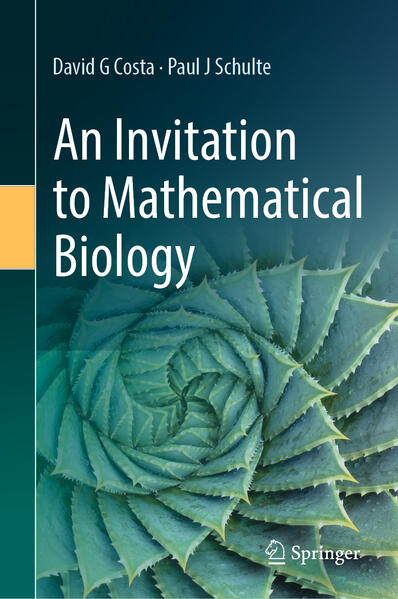
Zustellung: Do, 26.06. - Mo, 30.06.
Versand in 1-2 Wochen
VersandkostenfreiBestellen & in Filiale abholen:
The textbook is designed to provide a "non-intimidating" entry to the field of mathematical biology. It is also useful for those wishing to teach an introductory course. Although there are many good mathematical biology texts available, most books are too advanced mathematically for most biology majors. Unlike undergraduate math majors, most biology major students possess a limited math background. Given that computational biology is a rapidly expanding field, more students should be encouraged to familiarize themselves with this powerful approach to understand complex biological phenomena. Ultimately, our goal with this undergraduate textbook is to provide an introduction to the interdisciplinary field of mathematical biology in a way that does not overly terrify an undergraduate biology major, thereby fostering a greater appreciation for the role of mathematics in biology
Inhaltsverzeichnis
Preface. - 1 Introduction. - 2 Exponential Growth and Decay. - 2. 1 Exponential Growth. - 2. 2 Exponential Decay. - 2. 3 Summary. - 2. 4 Exercises. - 2. 5 References- 3 Discrete Time Models. - 3. 1 Solutions of the discrete logistic. - 3. 2 Enhancements to the Discrete Logistic Function. - 3. 3 Summary. - 3. 4 Exercises. - 3. 5 References- 4 Fixed Points, Stability, and Cobwebbing. - 4. 1 Fixed Points and Cobwebbing. - 4. 2 Linear Stability Analysis. - 4. 3 Summary. - 4. 4 Exercises. - 4. 5 References- 5 Population Genetics Models. - 5. 1 Two Phenotypes Case. - 5. 2 Three Phenotypes Case. - 5. 3 Summary. - 5. 4 Exercises. - 5. 5 References- 6 Chaotic Systems. - 6. 1 Robert May s Model. - 6. 2 Solving the Model. - 6. 3 Model Fixed Points. - 6. 4 Summary. - 6. 5 Exercises. - 6. 6 References- 7 Continuous Time Models. - 7. 1 The Continuous Logistic Equation. - 7. 2 Equilibrium States and their Stability. - 7. 3 Continuous Logistic Equation with Harvesting. - 7. 4 Summary. - 7. 5 Exercises. - 7. 6 References-. - 8 Organism-Organism Interaction Models. -8. 1 Interaction Models Introduction. - 8. 2 Competition. - 8. 3 Predator-Prey. - 8. 4 Mutualism. - 8. 5 Summary. - 8. 6 Exercises. - 8. 7 References- 9 Host-Parasitoid Models. - 9. 1 Beddington Model. - 9. 2 Some Solutions of the Beddington Model. - 9. 3 MATLAB Solution for the Host-Parasitoid Model. - 9. 4 Python Solution for the Host-Parasitoid Model. - 9. 5 Summary. - 9. 6 Exercises. - 9. 7 References- 10 Competition Models with Logistic Term. - 10. 1Addition of Logistic Term to Competition Models. - 10. 2 Predator-Prey-Prey Three Species Model. - 10. 3Predator-Prey-Prey Model Solutions. - 10. 4 Summary. - 10. 5Exercises. - 10. 6References- 11 Infectious Disease Models. - 11. 1 Basic Compartment Modeling Approaches. - 11. 2SI Model. - 11. 3SI model with Growth in S. - 11. 4 Applications using Mathematica. - 11. 5 Applications using MATLAB. - 11. 6 Summary. - 11. 7 Exercises. - 11. 8 References- 12 Organism Environment Interactions. - 12. 1 Introduction to Energy Budgets. - 12. 2 Radiation. - 12. 3 Convection. - 12. 4 Transpiration. - 12. 5 Total Energy Budget. - 12. 6 Solving the Budget: Newton s Method for Root Finding. - 12. 7 Experimenting with the Leaf Energy Budget. - 12. 8 Summary. - 12. 9 Exercises. - 12. 10 References- 13 Appendix 1: Brief Review of Differential Equations in Calculus- 14 Appendix 2: Numerical Solutions of ODEs- 15 Appendix 3: Tutorial on Mathematica- 16 Appendix 4: Tutorial on MATLAB- 17 Appendix 5: Tutorial on Python Programming- Index
Produktdetails
Erscheinungsdatum
02. Oktober 2023
Sprache
englisch
Auflage
2023
Seitenanzahl
136
Autor/Autorin
David G Costa, Paul J Schulte
Verlag/Hersteller
Produktart
gebunden
Abbildungen
IX, 124 p. 71 illus., 66 illus. in color.
Gewicht
377 g
Größe (L/B/H)
241/160/14 mm
ISBN
9783031402579
Entdecken Sie mehr
Pressestimmen
This very brief volume is designed for biology undergraduates with only a basic calculus background. it is very self contained, with the appendixes providing the basics of standard numerical packages. (Louis J. Gross, The Quarterly Review of Biology, Vol. 100 (1), March, 2025)
I think the authors have succeeded in their goal of providing an `invitation to mathematical biology. Not only can this book serve as a stepping stone to more comprehensive mathematical biology books, it also offers the reader a glimpse into a variety of topics that they can pursue in deeper detail later on if they are interested. (Anita T. Layton, SIAM Review, Vol. 66 (3), August, 2024)
Bewertungen
0 Bewertungen
Es wurden noch keine Bewertungen abgegeben. Schreiben Sie die erste Bewertung zu "An Invitation to Mathematical Biology" und helfen Sie damit anderen bei der Kaufentscheidung.









